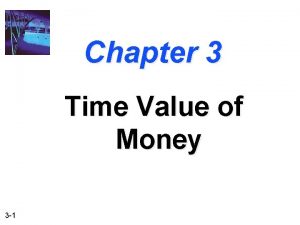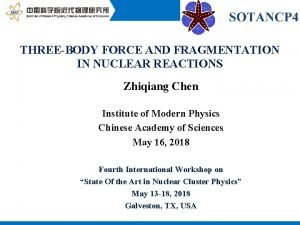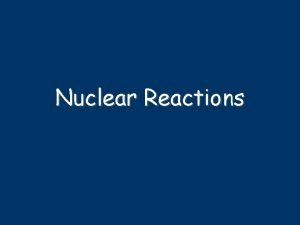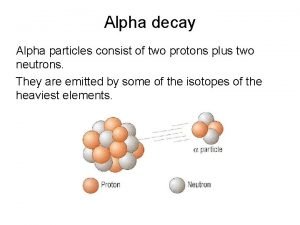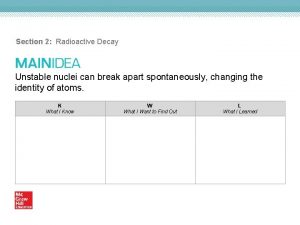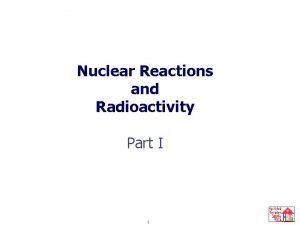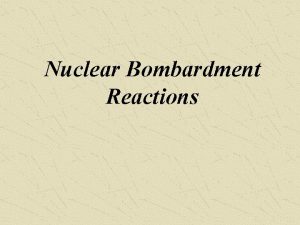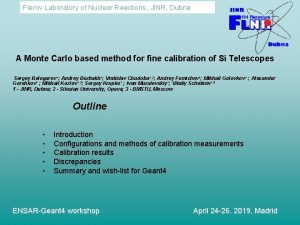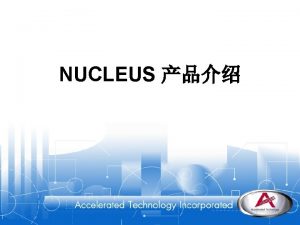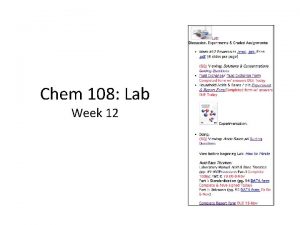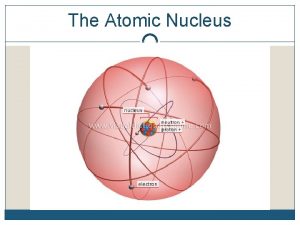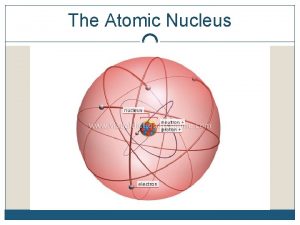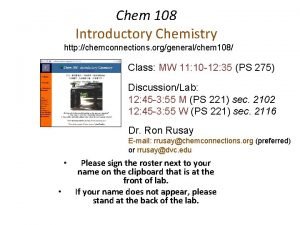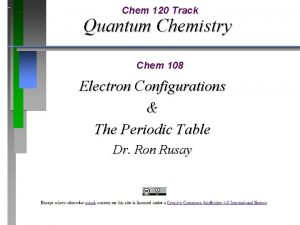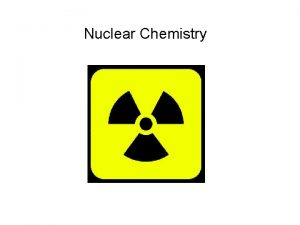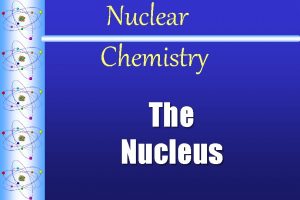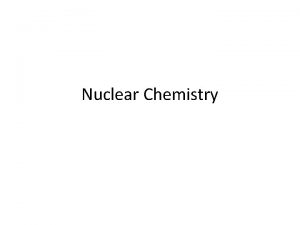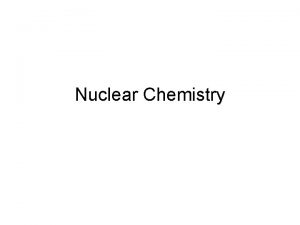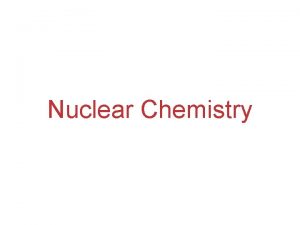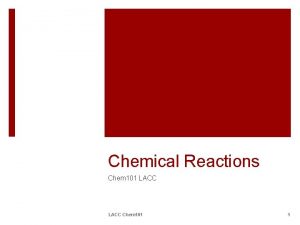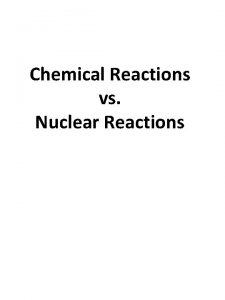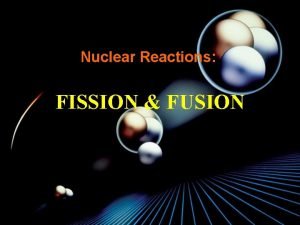CHEM 108 The Nucleus Nuclear Reactions Nuclear Reactions




















- Slides: 20

CHEM 108 The Nucleus _____ Nuclear Reactions

Nuclear Reactions The mass of the visible universe is 73% H 2 and 25% He. The remaining 2%, “heavy” elements, have atomic masses > 4. ¥ The “heavy” elements are formed at very high temperatures (T >10 6 o. C) by FUSION, i. e. nuclei combining to form new elements. ¥ There is an upper limit to the “natural” production of heavy nuclei at Atomic Number = 92, Uranium. ¥ Heavier nuclei split to lighter ones by FISSION ¥

Nuclear Reactions: Fission: ¥ ¥ Fusion: Fission and Fusion reactions are highly exothermic; they give off a tremendous amount of energy. The energy produced in “nuclear” reactions is one million (10 6) times larger than “chemical” reactions per atom.

Nuclear Reactions / Fission ¥ ¥ ¥ The Fission Chain Reaction proceeds geometrically: 1 neutron 3 9 27 81 neutrons etc. 1 Mole of U-235 (235 grams, about 1/2 lb) produces 2 x 1010 k. J which is equivalent to the combustion of 800 tons of coal, which is more than 1. 75 million pounds of coal! Commercial nuclear reactors use fission to produce electricity. . Fission bombs were used in the destruction of Hiroshima and Nagasaki, Japan, in August 1945.

Nuclear Reactions / Fission President Truman / Hiroshima http: //hiroshima. mapping. jp/ge_en. html August 6, 1945 http: //hiroshima. mapping. jp/ge_en. html

The Nuclear Dawn August 6, 1945

Nuclear Power Plant

Worldwide Nuclear Power Plants

Chernobyl, Ukraine April, 1986; April, 2001; August, 2016

Nuclear Plant Disaster March 2011 Fukushima, Japan

Fukushima Radiation http: //www. pbs. org/newshour/bb/science/july-dec 11/japanradiation_11 -10. html 1 millisievert (m. Sv) = 100 mrem 0. 01 Sievert (Sv) = 1 rem

QUESTION Which of the following is/are true of fission reactors that produce electricity? A. The reactors boil water. B. Relatively small amounts of fuel are needed. C. Fission based reactors produce much more energy than coal-burning power plants with the same amount of fuel. D. Fission reactors produce toxic waste that have very long half-lifes and Nuclear accidents are possible. E. All of the above

NUCLEAR ENERGY ¥ EINSTEIN’S EQUATION FOR THE CONVERSION OF MASS INTO ENERGY 2 ¥E = mc ¥ m = mass (kg) c = Speed of light 8 c = 2. 998 x 10 m/s ¥

A nucleon is either a proton or a neutron; its mass = 1 amu = 1. 66054 x 10 -27 kg

QUESTION When a 235 U nucleus absorbs a high energy neutron and undergoes nuclear fission, it undergoes a chain reaction that produces 141 Ba, plus 92 Kr, and 3 neutrons. When a 235 U nucleus absorbs a slow moving, low energy neutron, it produces 2 neutrons, plus 94 Sr. What is the other nuclide produced? A. 141 Ba B. 140 Ba C. 91 Kr D. 140 Xe E. 141 Xe http: //physics. bu. edu/~duffy/sc 546_notes 11/fission. html

Mass Energy Electron volt (ev) The energy an electron acquires when it moves through a potential difference of one volt: 1 ev = 1. 602 x 10 -19 J Nuclear Binding energies are commonly expressed in units of megaelectron volts (Mev) 1 Mev = 106 ev = 1. 602 x 10 -13 J A particularly useful factor converts a given mass defect in atomic mass units to its energy equivalent : 1 amu = 931. 5 x 106 ev = 931. 5 Mev = 3. 829 x 10 -17 kcal

Binding Energy per Nucleon of Deuterium GIVEN: Deuterium has a mass of 2. 01410178 amu. Hydrogen atom mass = 1 x 1. 007825 amu = 1. 007825 amu Neutron mass = 1 x 1. 008665 amu = 1. 008665 amu 2. 016490 amu Mass difference = theoretical mass - actual mass = 2. 016490 amu - 2. 01410178 amu = 0. 002388 amu Binding energy per nucleon: Binding energy Nucleon = -0. 002388 amu x 931. 5 Mev/amu 2 nucleons = -1. 1123 Mev 2. 01410178 grams (0. 002 kg/ 0. 0044 lbs) = -2. 26 x 107 kcal Enough energy to boil 488 liters of water (over 125 gallons)

Nuclear Reactions / Fusion ¥ ¥ Fusion has been described as the chemistry of the sun and stars. It too has been used in weapons and has not yet found a peaceful commercial applicationç n. Fusion has great promise in producing relatively “clean” abundant energy through the combination of Hydrogen isotopes particularly from 2 H, deuterium and 3 H, tritium: (NIF/National Ignition Facility, LLNL & ITER, France)

QUESTION Which of the following is/are true of fusion designed reactors that will be used to produce electricity? A. The reactors will boil water. B. Relatively small amounts of fuel will be needed, and there will be less radioactive waste. C. Fusion reactors will produce much more energy than fission based reactors with the same amount of fuel. D. Nuclear accidents are possible. E. All of the above

Another Type of Nuclear Reaction Genesis of 14 C in living organisms https: //www. youtube. com/watch? v=ph. Ze. E 7 Att_s #1: Formation of Carbon-14 in the upper atmosphere #2: Beta decay of Carbon-14 #3: 14 C/12 C in living organisms; [Photosynthesis produces a steady state ratio of 14 C/12 C while living. ] In dead organisms C-14 decays (#2); the ratio and concentration of C 14 decreases; the ratio is used to date artefacts up to > 40, 000 yrs
 360-108-108
360-108-108 Solve for f fva=(c((1 0.108/12)^120-1))/(0.108/12)
Solve for f fva=(c((1 0.108/12)^120-1))/(0.108/12) Lesson 15 nuclear quest nuclear reactions
Lesson 15 nuclear quest nuclear reactions Fisión nuclear vs fision nuclear
Fisión nuclear vs fision nuclear Nuclear reactions are at
Nuclear reactions are at Nuclear transmutation equation
Nuclear transmutation equation Alpha decay uranium 238
Alpha decay uranium 238 Key terms radioactivity and nuclear reactions
Key terms radioactivity and nuclear reactions Balancing nuclear reactions
Balancing nuclear reactions Two types of nuclear reactions
Two types of nuclear reactions Nuclear decays and reactions section 2
Nuclear decays and reactions section 2 Balance nuclear equations
Balance nuclear equations Nuclear bombardment equation
Nuclear bombardment equation Alpha beta gamma neutron
Alpha beta gamma neutron Flerov laboratory of nuclear reactions
Flerov laboratory of nuclear reactions Chemical reactions section 3 reactions in aqueous solutions
Chemical reactions section 3 reactions in aqueous solutions Section 2 reinforcement classifying chemical reactions
Section 2 reinforcement classifying chemical reactions Unit 5 chemical reactions answers
Unit 5 chemical reactions answers Reduction half reaction
Reduction half reaction Section 2 classifying chemical reactions
Section 2 classifying chemical reactions Simplify radical 108
Simplify radical 108

